 Facebook
Facebook
 X
X
 Instagram
Instagram
 TikTok
TikTok
 Youtube
Youtube
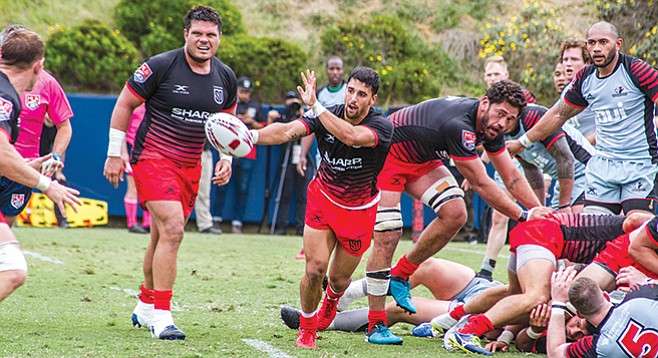
When the Chargers followed that red ribbon of brakelights leading to Los Angeles, our city’s abandoned football fans responded by burning jerseys and searching for clever ways to repurpose their bolt tattoos. After an ugly split, we straightened our backs, dusted ourselves off, and moved on. We said so long to the NFL’s culture of concussions, domestic abuse, and public subsidies, and hello to a future supporting other professional team sports.
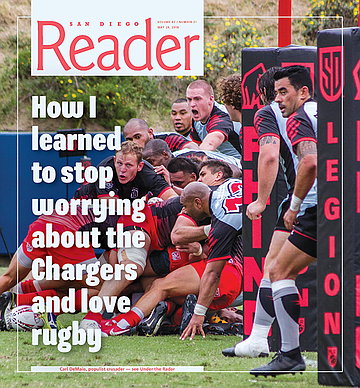
Other professional team sports have responded in typical San Diego fashion. This year’s Gulls minor league hockey team missed the playoffs by the slimmest of margins after a late season slump. The Padres parlayed a “rebuilding” 2017 season into a 2018 that, so far, has been a race to last place. As of May 15 they were already nine games out of first place.
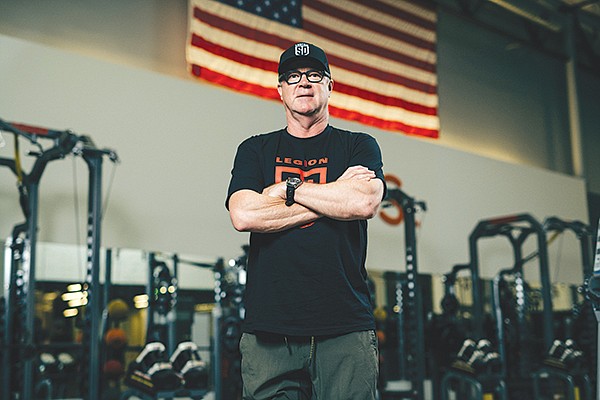
No sooner had the Chargers announced their decision to leave, than a SoccerCity ownership group emerged to commence an extended flirtation with bringing a Major League Soccer team to San Diego.
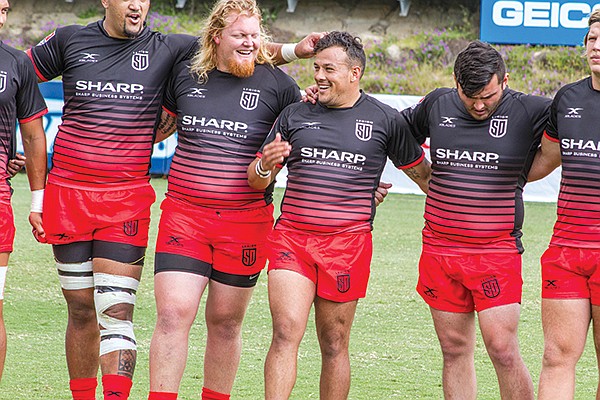
Unfortunately, the years of foreplay required to lure an MLS expansion franchise have started to feel distastefully similar to the public relations mess winding up to the Chargers’ departure: demands for a new stadium, a fractious public vote, and that unsavory cocktail of politicians making deals with developers.

Perhaps would-be San Diego soccer fans were experiencing a sort of pro sports franchise fatigue last year when, responding to a promotional poll set up by SoccerCity, they voted to give this hypothetical soccer team the most absurd nickname available: Footy McFooty Face.
As the largest U.S. city that has never won a professional team championship, San Diego fanatics have learned to make self-deprecation a point of pride.
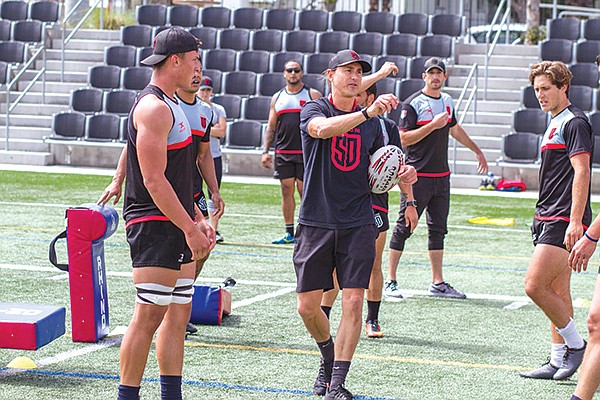
So it came as refreshing surprise when, seemingly out of nowhere, Major League Rugby appeared in February to announce that San Diego will be one of seven American cities to field a professional rugby team in 2018. And that — by the way — there’s Major League Rugby now. Its first season is underway, it will be televised nationally, and its inaugural championship game will be hosted right here in San Diego this July.
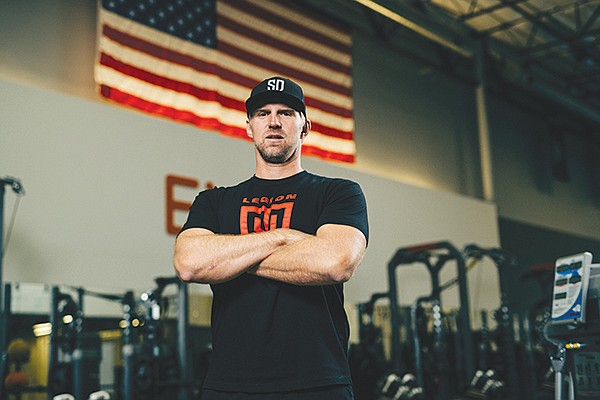
Just like that, without any great teasing, debate, land grabs, or public funding, our city is the proud home of a new team: San Diego Legion. Fifteen men in red and black, playing without pads, without helmets, and without the seven-figure paychecks. Just like that, contact sports fans around the city have been given a chance to perk up, high five, and ask the suddenly relevant question: do we like rugby now?
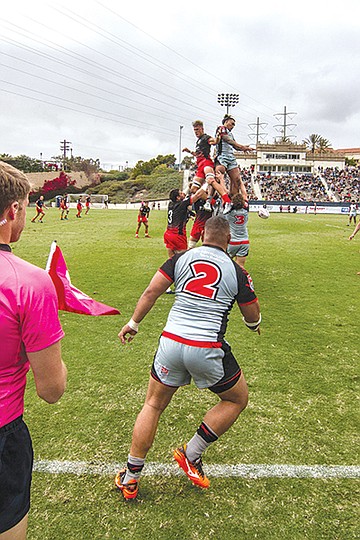
The short answer is: yes. We’ve liked rugby for 60 years.
Most of rugby’s history in San Diego involves club teams — night and weekend athletes playing in organized competitions against other regional clubs of the Southern California Rugby Football Union, which sends its top team to annual national tournaments.
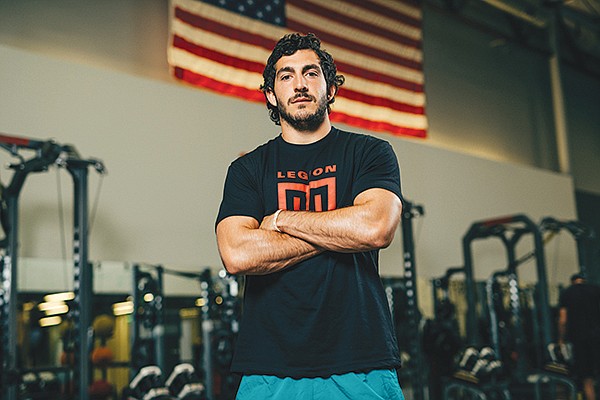
First of the bunch is Old Mission Beach Athletic Club. Best known for organizing the annual Over the Line Tournament, the club established a Rugby Football Club in 1966, and has consistently ranked among the top echelon of American club rugby since. In 52 years, Old Mission Beach has 15 national championships.
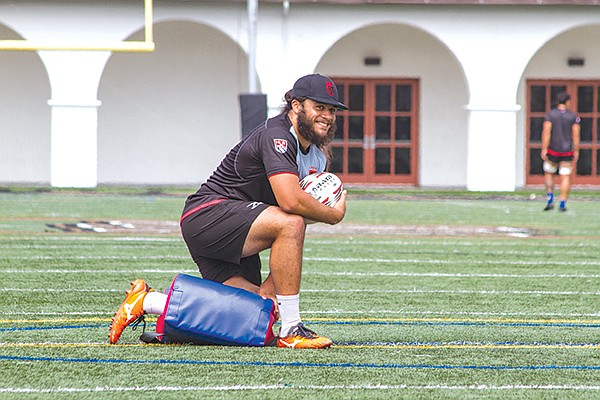
Other local teams have sprung up over time, including the Oceanside Chiefs, North County Gurkhas (playing in Escondido), and San Diego Old Aztecs, which was founded by San Diego State University alumni in 1978. Organized rugby at the university itself dates back to 1958, which is still relatively young compared to century-old rugby programs of northern California universities such as Stanford and Berkeley.
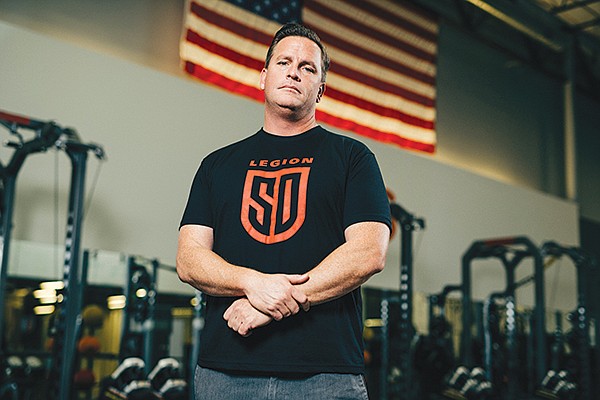
The United States isn’t exactly viewed as a rugby powerhouse, but thanks to players from those colleges, we do hold an interesting distinction: the U.S. has more Olympic gold medals for rugby than any other nation. We earned our first gold at the 1920 Olympics in Antwerp, Belgium, when the only other country to field a team was the heavily favored France. And we repeated in 1924, despite Romania joining the fray.
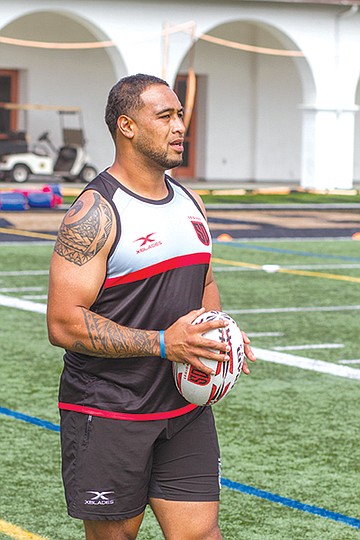
But the sport was dropped from the official Olympics program and did not return to medal competition for 92 years. The 2016 summer games in Rio featured a rugby sevens tournament — seven-player teams playing 14 minute games — for both men and women.
United States rugby did not medal in the 2016 Olympics, but its participation has had a massive impact on rugby in San Diego. That’s because, in 2009, when the Olympic committee voted to return rugby to the summer games, the U.S. national rugby teams moved to San Diego to train at what was then called the Olympic Training Center in Chula Vista. Thanks to that lucky bit of geography, eleven players on the Legion’s 27-man roster have played with Team USA.
The missing link between soccer and American football, rugby predates the American game by half a century, purportedly started in 1823 by an irreverent British teen who flouted the first rule of British football: don’t use your hands. As the story goes, a student at the Rugby School in central England picked up the ball and ran with it until he was tackled, and two centuries later, watching men violently chase each other around a field is the one of the world’s most popular and profitable pastimes.
Rugby enthusiasts have described it to me a number of ways: as football played at soccer’s pace, or like basketball with tackling. Most of the action is similar to that one desperation play at the end of a football game, when clocks runs out and the team with the ball will lose the game if a player is tackled, so the players keep pitching the ball to each other as they scramble around the field. In that moment, we can clearly see how American football evolved from rugby.
Rugby is responsible for the oblong ball, for example, which got its shape, prior to the advent of rubber, from practice of sewing inflated pig bladders inside the leather ball to give it some bounce. Hence the name, pigskin.
The word touchdown comes from rugby, in which a player literally has to touch the ball down on the ground beyond the goal line to earn points. Ironically, football doesn’t require this literal touch down, and in rugby it’s not called a touchdown at all. It’s called a try. As in, the home team scored a try for five points. Or the visiting team scored two tries in the first half, but didn’t make it into the try zone in the second.
Much of Rugby’s distinctive glossary feels charmingly British. For example, when a player breaks the rules it’s called an infringement — though a serious infringement is still called a penalty.
As in soccer, a rugby game is called a match, the field is called the pitch, and there’s no forward passing at all: throwing or even fumbling the ball forward is called a knock on, an infringement. So players toss the ball laterally to each other to find a break in the defense, sometimes on the opposite sideline — that is, the touchline.
The most fun rugby terms have to do with blocking and tackling, such as a protective ruck, or a maul. Rugby’s best-known oddball term is the scrum, a choreographed pile of players pushing against each other determine possession of the ball.
Another eye-popping set piece that bears zero resemblance to a football play is called ato capture the ball at its highest point.
The full set of rules and phrases can take a while to learn — for instance, there are three different ways to score points by kicking field goals — but full understanding isn’t required to enjoy game viewingß. Spectators can count on many of the same thrills football provides, including fast runners juking defenders to make them miss, and big defenders making hard hitting tackles when those jukes fail.
Each year since its return to the Olympics was announced, rugby has gained popularity in the U.S., and the men behind Major League Rugby and San Diego Legion believe that number has reached the levels needed to support a professional league. In part, because some of them have been building the infrastructure to sustain it for over a decade.
“I think we’re now at that point where there’s enough critical mass,” says Matt Hawkins, who should know. The Durban, South Africa native been substantially involved with every level of local rugby culture since moving here 16 years ago. Hawkins played a huge role in making sure San Diego is a part of the new league, and is the Legion’s president and general manager.
Hawkins grew up dreaming about playing professional rugby, but fell hard for San Diego while visiting family here as a teen. He moved here permanently after college and pursued a career in advertising. He’s now a US citizen, but he never got rugby out of his system, and eventually left his job to focus on rugby full time. “It’s very raw in its nature, if that makes sense,” explains Hawkins. “I can’t get that same competition in a board room.”
He went from playing in weekly pickup games on the beach in Del Mar, to winning championships at a semi-pro level with Old Mission Beach Athletic Club, to playing for the U.S. men’s national team, a couple as team captain. He eventually became its coach and served on the board of its umbrella organization, USA Rugby. He’s also coached local club teams, at San Diego State University, and for the U.S. Marine Corps rugby squad. If it has to do with rugby in San Diego, Matt Hawkins has probably had a hand in it.
That includes the San Diego Breakers, the city’s last stab at a professional rugby team. Hawkins worked as an assistant coach for the Breakers, and also as San Diego director of operations for the league it played in, PRO Rugby. The Breakers put in a 12-game season in 2016, but by the end of that year, the New York financier who solely owned PRO Rugby canceled player and coach contracts amid a convoluted dispute with USA Rugby, and the league disintegrated.
While nobody involved with Major League Rugby wants to offer an opinion why PRO Rugby flamed out so quickly, players and coaches insist any problems were organizational, not due to lack of fan support. They don’t see it as a matter of whether pro rugby will succeed in the U.S., but when. Because while convincing former Chargers fans to come watch rugby would be great, the real target of this league is the next generation of sport fans.
The kids are into it
Rugby has been declared America’s fastest growing sport, and in a media environment where even some NFL players don’t want their kids playing American football, youth rugby in particular is taking off. From Hawkins’s perspective, San Diego has been a great part of this cultural shift. “The last ten years,” he says, “[youth rugby] and high school is where I’ve seen the most explosion.”
At the college level, American universities now field 800 to 900 teams, rostering 32,000 male and female student athletes. National organization USA Rugby reports more than 115,000 Americans playing organized rugby — up 40 percent from 82,000 in 2010.
But rugby has always been played at American colleges, and by people who used to play in college. What’s making these numbers rise, says Hawkins, is that a new generation of kids have been growing up with the sport. He’s been working to further the trend, running a rugby training academy in Carlsbad, and founding Encinitas youth club, the Coastal Dragons.
Some estimates claim as many as 50,000 kids now participate in youth rugby programs nationwide. Locally, SoCal Youth Rugby oversees a system where boys and girls start playing in non-tackle U-8 leagues (under 8 years old), the growing into gradual contact U-10 and U-12 leagues. The genders split for U-14 teams and into high school.
Legion chief financial officer David Pool serves as the president of SoCal Youth Rugby, where he says youth participation has more than doubled since 2010. He reports the number of kids playing rugby in that time has risen from 2900 to an expected 6000 this year, and that rugby is now played by over 100 local high schools.
Originally form Christchurch, New Zealand, Pool played youth rugby himself, starting in a touch league at five years old. He’d settled in Del Mar to raise a family by 2011, when he was recruited to coach his son’s youth league team, the San Diego Mustangs, because he was the only parent who’d played rugby before.
He’s been coaching and administrating youth rugby since, and Pool cites two phenomena that he’s seen attracting more kids to the sport in recent years: coverage of rugby at the 2016 summer Olympics, and coverage of concussion risk in American football.
“One of the big things a lot of parents talk to me about is to compare and contrast football,” Pool says. There’s a key difference between the two tackle sports, as he sees it. “Football is a game of collision where rugby is a game of evasion,” he says. With pads and helmets on, football players tend to collide head on. With no pads on, rugby players are more likely to grab and grapple to tackle, keeping their heads relatively out of it. “One of the things our club really focuses on is those tackling techniques,” Pool emphasizes, “It’s making sure you keep your head out of the game.”
When the Legion played a preseason match in early April, there were hundreds of children in the stands. At the moment, it seems much more likely they will grow up watching live professional rugby in San Diego than professional football.
As David Pool notes, “We’re closing the circle between youth rugby and professional rugby. My thing is to support the Legion, and that SD Legion will turn around and support youth rugby.”
Who are these guys?
At a February press conference announcing the Legion’s season, league commissioner Dean Howes echoed these sentiments, stating, “We want this generation of player to believe that they’re at the highest level of rugby here in the United States, and we want the next generation to aspire to be them.”
Professional sports thrive on the success of their star athletes, and there are few star rugby athletes in the U.S. As the league limits each team to no more than five international players, fielding quality local players is important to every team’s success. Having members of the U.S. men’s team right here in town gives the Legion a solid lead on featuring stars of the sport.
Matt Hawkins took the lead assembling the Legion squad, and recruited several Team USA players under the league’s $250,000 salary cap. That’s not an absolute cap, but a pool of money meant to attract more accomplished players. Hawkins has discretion to apply that total to as many as he deems fit.
To round out teams, the league established a fixed associate player rate that Hawkins used to recruit from an emerging pool of local talent: club and student athletes he knows thanks to his close ties with Old Mission Beach Athletic Club, the Old Aztecs, and San Diego State. These are guys who will now have a chance to train and play at the elite level of professional athletes, and as the League progresses, so will America’s chances in the highest level of competition, the international game.
“We’re increasing the level of rugby that we have, as far as the individual rugby player and their rugby IQs,” Hawkins suggests. “We now have more ability to develop better players, which will have great impact on the national team.”
The team clearly improves the immediate prospects for some of the associate players. One is Gil Covey, a local dude from City Heights, who played for Cathedral Catholic High School, and the Aztecs. Covey graduated from San Diego State in December, and has been working the door at a local bar, PB Shore Club, to make ends meet, while making time for the intensive training and nutrition regimen established by Legion coaching staff.
Nick Evans, an experienced young athlete with experience playing for semi-pro teams in Seattle and overseas, moved here to support his girlfriend, who plays for the women’s U.S. national rugby team. He was picked up by Legion after a strong year playing for Old Mission Beach, and seeks to build on this pro experience..
“Four years ago there weren’t that many paid roles, really, in America,” says Legion head coach Rob Hoadley, “It’s awesome to see how it’s changing.” A London native, Hoadley played professionally in the U.K. for eight years prior to coming to the U.S. to coach at Stanford, then with Hawkins on the Breakers.
Hoadley says the Legion has assembled a team that can play fast, with intelligence, and yet still apply brute force as the pace of the game dictates. “Ultimately, it’s a battle to find either physical dominance or space on the pitch,” he explains, “You’ve got to be able to do both.”
Among the team’s star athletes is Mike Te’o, who scored the most tries during the Breakers opening game, and also plays for Team USA. Originally from Long Beach, his first experience watching rugby was here in San Diego in 2009, when his father brought him down to watch a sevens tournament at Petco Park. In one of the games they watched, the U.S. men’s national team played against that of his dad’s birthplace, Samoa.
“That was the first time I actually saw rugby, and I fell in love with it,” Te’o recalls. “Three years later I was playing in that same tournament.”
Te’o plays fullback, which is usually the first to touch the ball on offense, and the last line of defense. Before he started playing rugby, he weighed 250 pounds, and played defensive tackle for his high school football team. Today he’s a leaner 210, despite gaining muscle. Compared to his football days, he says, “I’m definitely stronger.”
Like many of Legion’s potential fans, a lot of the players are football converts. An associate player on the Legion, Sione Tu’ihalamaka, played defensive end for the University of Arizona, and at 6’2”, 280 pounds, he once aspired to play in the NFL. However, after college, he converted to rugby, and quickly wound up on the Breakers roster.
Tu’ihalamaka says the biggest adjustment coming to rugby from football is staying on the field all game, and running the whole time. “You don’t get to tackle guys weighing 250,” he says with a laugh, “but at the same time you’re doing 80 minutes on a soccer field… it tests your character.”
He plays a position called forward prop; a scrumming position. While rugby positions do sometimes specialize in areas such as kicks, returns, and set pieces, for the most part every player on the team must be able to throw the ball, catch the ball, tackle, and run. While he still excels at the tackling, Tu’ihalamaka particularly enjoys that rugby gives him chance to use all those other skills.
“You get to run the ball, you get to score a touchdown,” he says, dropping into football parlance as a smile spreads across his face. “A big guy like me, you don’t ever get to score a touchdown.”
But not all our rugby athletes tried football first. Another of the team’s top players exemplifies the potential future of American rugby. “I got into rugby because my dad played,” says Ryan Matyas, “Some of my first memories as a kid was on the sideline of his games, running around tackling the other kids, playing with the ball on the sideline.”
The Tuscon native started playing touch rugby at 8, tackle at 12, and went on to be a state champion high school player in Arizona. He played at University of Arizona, but only after a season playing professionally in Wales. He previously played for the Breakers, and also played on Team USA.
“I always wanted to play rugby,” Matyas says, and he relishes the chance to pay professionally in the U.S. “Even though you’ve got to be up at 5am, you’ve got to be in bed by 8. I love it,” he says, “I wake up every day and I love what I do.”
And, remember how David Pool wound up coaching his youth club, the Mustangs, because none of the dads or moms had played the game? That’s less of a problem now. In between tours with the national team, Matyas has taken time to coach the Mustangs, bringing a higher degree of understanding of the game to our next crop of local players.
Ownership appeal
In a way, those same Mustangs are responsible for there being a San Diego Legion.
Real estate developer Ryan Patterson did not grow up playing rugby, and when his young sons were ready for organized sports, he signed them up for football and volunteered to coach. A fellow football parent also coached winter youth rugby, and after the football season ended, convinced father and sons to participate. “I helped out the first couple seasons,” Patterson says, recalling he liked it. “But,” he adds, “my kids fell in love with it!”
His children involved their friends, who brought other friends to play. Over the past seven years Patterson has watched greater crowds of local children discover rugby with every season, following the U.S. national teams, and aspiring to play competitively in high school, college, and beyond.
So when Matt Hawkins and David Pool told Patterson about the chance to bring a new team to San Diego last July, Patterson saw enough long term potential in the opportunity to commit the $570 thousand ownership fee required for the team to join Major League Rugby.
It didn’t hurt his calculations that San Diego was about to be left out of the professional football for the first time since 1961. “I certainly see the vacuum left by the Chargers,” he says, “San Diego really wants a sports team and pro sports culture, and I saw the opportunity to fill that void.”
Recent history suggests that a $570 thousand risk could yield big returns, in the long run. The fee to join Major League Soccer, after which MLR is modeled, is up to $150 million. Major League Soccer has been around for 22 years now, and features teams now valued at a quarter billion dollars. But it wasn’t always a sure thing either; the league reportedly lost a quarter billion during its first five seasons.
For the moment, Major League Rugby is committed to at least two seasons, and both ESPN and CBS Sports have committed to television broadcasts through 2019. The money for TV rights goes to the league, while Legion gets to sell allotted commercial time during local broadcasts to supplement the income from merchandising and ticket sales, which range in price from $23 to $34.
But Patterson speaks in terms of five to ten years or more before seeing a return on investment, and fully expects to wait it out. “We see long term viability here in San Diego,” he says. Since founding the Legion, Patterson has bolstered the team’s finances by adding a second ownership group, led by former South African rugby pro Bob Skinstad. “We’re committed financially to the team,” Patterson says, “As long as the fans want rugby, we’re committed to it.”
The league launched on April 22nd — a loss to the Seattle Seawolves The Legion’s first home game, played at the University of San Diego’s Torero Stadium on April 29th, was a win over the the Utah Warriors. A home win over the Houston SaberCats and an away loss to the Glendale Raptors (of Colorado) have followed. Next up for the Legion, a May 25 away match against Austin Elite Rugby in Texas. The next home match is on June 17, also against Austin Elite.
The league championship game will be hosted here in San Diego on July 7th. Next year, a second season will run longer, beginning as soon as January.
The earliest San Diego could have a Major League Soccer team is 2020, which gives Major League Rugby a good couple of gap years to establish itself before any competition rolls into town. For the moment, it’s not asking a lot — two or three thousand spectators coming to four home games in a stadium that can fit about six thousand. Maybe a little home team affection.
Time will tell whether San Diego embraces the sport. But if rugby doesn’t capture our sporting imagination, don’t lose hope. Rumor has it a Major League Lacrosse team is slated to debut here in November.


When the Chargers followed that red ribbon of brakelights leading to Los Angeles, our city’s abandoned football fans responded by burning jerseys and searching for clever ways to repurpose their bolt tattoos. After an ugly split, we straightened our backs, dusted ourselves off, and moved on. We said so long to the NFL’s culture of concussions, domestic abuse, and public subsidies, and hello to a future supporting other professional team sports.

Other professional team sports have responded in typical San Diego fashion. This year’s Gulls minor league hockey team missed the playoffs by the slimmest of margins after a late season slump. The Padres parlayed a “rebuilding” 2017 season into a 2018 that, so far, has been a race to last place. As of May 15 they were already nine games out of first place.

No sooner had the Chargers announced their decision to leave, than a SoccerCity ownership group emerged to commence an extended flirtation with bringing a Major League Soccer team to San Diego.

Unfortunately, the years of foreplay required to lure an MLS expansion franchise have started to feel distastefully similar to the public relations mess winding up to the Chargers’ departure: demands for a new stadium, a fractious public vote, and that unsavory cocktail of politicians making deals with developers.

Perhaps would-be San Diego soccer fans were experiencing a sort of pro sports franchise fatigue last year when, responding to a promotional poll set up by SoccerCity, they voted to give this hypothetical soccer team the most absurd nickname available: Footy McFooty Face.
As the largest U.S. city that has never won a professional team championship, San Diego fanatics have learned to make self-deprecation a point of pride.

So it came as refreshing surprise when, seemingly out of nowhere, Major League Rugby appeared in February to announce that San Diego will be one of seven American cities to field a professional rugby team in 2018. And that — by the way — there’s Major League Rugby now. Its first season is underway, it will be televised nationally, and its inaugural championship game will be hosted right here in San Diego this July.

Just like that, without any great teasing, debate, land grabs, or public funding, our city is the proud home of a new team: San Diego Legion. Fifteen men in red and black, playing without pads, without helmets, and without the seven-figure paychecks. Just like that, contact sports fans around the city have been given a chance to perk up, high five, and ask the suddenly relevant question: do we like rugby now?

The short answer is: yes. We’ve liked rugby for 60 years.
Most of rugby’s history in San Diego involves club teams — night and weekend athletes playing in organized competitions against other regional clubs of the Southern California Rugby Football Union, which sends its top team to annual national tournaments.

First of the bunch is Old Mission Beach Athletic Club. Best known for organizing the annual Over the Line Tournament, the club established a Rugby Football Club in 1966, and has consistently ranked among the top echelon of American club rugby since. In 52 years, Old Mission Beach has 15 national championships.

Other local teams have sprung up over time, including the Oceanside Chiefs, North County Gurkhas (playing in Escondido), and San Diego Old Aztecs, which was founded by San Diego State University alumni in 1978. Organized rugby at the university itself dates back to 1958, which is still relatively young compared to century-old rugby programs of northern California universities such as Stanford and Berkeley.

The United States isn’t exactly viewed as a rugby powerhouse, but thanks to players from those colleges, we do hold an interesting distinction: the U.S. has more Olympic gold medals for rugby than any other nation. We earned our first gold at the 1920 Olympics in Antwerp, Belgium, when the only other country to field a team was the heavily favored France. And we repeated in 1924, despite Romania joining the fray.

But the sport was dropped from the official Olympics program and did not return to medal competition for 92 years. The 2016 summer games in Rio featured a rugby sevens tournament — seven-player teams playing 14 minute games — for both men and women.
United States rugby did not medal in the 2016 Olympics, but its participation has had a massive impact on rugby in San Diego. That’s because, in 2009, when the Olympic committee voted to return rugby to the summer games, the U.S. national rugby teams moved to San Diego to train at what was then called the Olympic Training Center in Chula Vista. Thanks to that lucky bit of geography, eleven players on the Legion’s 27-man roster have played with Team USA.
The missing link between soccer and American football, rugby predates the American game by half a century, purportedly started in 1823 by an irreverent British teen who flouted the first rule of British football: don’t use your hands. As the story goes, a student at the Rugby School in central England picked up the ball and ran with it until he was tackled, and two centuries later, watching men violently chase each other around a field is the one of the world’s most popular and profitable pastimes.
Rugby enthusiasts have described it to me a number of ways: as football played at soccer’s pace, or like basketball with tackling. Most of the action is similar to that one desperation play at the end of a football game, when clocks runs out and the team with the ball will lose the game if a player is tackled, so the players keep pitching the ball to each other as they scramble around the field. In that moment, we can clearly see how American football evolved from rugby.
Rugby is responsible for the oblong ball, for example, which got its shape, prior to the advent of rubber, from practice of sewing inflated pig bladders inside the leather ball to give it some bounce. Hence the name, pigskin.
The word touchdown comes from rugby, in which a player literally has to touch the ball down on the ground beyond the goal line to earn points. Ironically, football doesn’t require this literal touch down, and in rugby it’s not called a touchdown at all. It’s called a try. As in, the home team scored a try for five points. Or the visiting team scored two tries in the first half, but didn’t make it into the try zone in the second.
Much of Rugby’s distinctive glossary feels charmingly British. For example, when a player breaks the rules it’s called an infringement — though a serious infringement is still called a penalty.
As in soccer, a rugby game is called a match, the field is called the pitch, and there’s no forward passing at all: throwing or even fumbling the ball forward is called a knock on, an infringement. So players toss the ball laterally to each other to find a break in the defense, sometimes on the opposite sideline — that is, the touchline.
The most fun rugby terms have to do with blocking and tackling, such as a protective ruck, or a maul. Rugby’s best-known oddball term is the scrum, a choreographed pile of players pushing against each other determine possession of the ball.
Another eye-popping set piece that bears zero resemblance to a football play is called ato capture the ball at its highest point.
The full set of rules and phrases can take a while to learn — for instance, there are three different ways to score points by kicking field goals — but full understanding isn’t required to enjoy game viewingß. Spectators can count on many of the same thrills football provides, including fast runners juking defenders to make them miss, and big defenders making hard hitting tackles when those jukes fail.
Each year since its return to the Olympics was announced, rugby has gained popularity in the U.S., and the men behind Major League Rugby and San Diego Legion believe that number has reached the levels needed to support a professional league. In part, because some of them have been building the infrastructure to sustain it for over a decade.
“I think we’re now at that point where there’s enough critical mass,” says Matt Hawkins, who should know. The Durban, South Africa native been substantially involved with every level of local rugby culture since moving here 16 years ago. Hawkins played a huge role in making sure San Diego is a part of the new league, and is the Legion’s president and general manager.
Hawkins grew up dreaming about playing professional rugby, but fell hard for San Diego while visiting family here as a teen. He moved here permanently after college and pursued a career in advertising. He’s now a US citizen, but he never got rugby out of his system, and eventually left his job to focus on rugby full time. “It’s very raw in its nature, if that makes sense,” explains Hawkins. “I can’t get that same competition in a board room.”
He went from playing in weekly pickup games on the beach in Del Mar, to winning championships at a semi-pro level with Old Mission Beach Athletic Club, to playing for the U.S. men’s national team, a couple as team captain. He eventually became its coach and served on the board of its umbrella organization, USA Rugby. He’s also coached local club teams, at San Diego State University, and for the U.S. Marine Corps rugby squad. If it has to do with rugby in San Diego, Matt Hawkins has probably had a hand in it.
That includes the San Diego Breakers, the city’s last stab at a professional rugby team. Hawkins worked as an assistant coach for the Breakers, and also as San Diego director of operations for the league it played in, PRO Rugby. The Breakers put in a 12-game season in 2016, but by the end of that year, the New York financier who solely owned PRO Rugby canceled player and coach contracts amid a convoluted dispute with USA Rugby, and the league disintegrated.
While nobody involved with Major League Rugby wants to offer an opinion why PRO Rugby flamed out so quickly, players and coaches insist any problems were organizational, not due to lack of fan support. They don’t see it as a matter of whether pro rugby will succeed in the U.S., but when. Because while convincing former Chargers fans to come watch rugby would be great, the real target of this league is the next generation of sport fans.
The kids are into it
Rugby has been declared America’s fastest growing sport, and in a media environment where even some NFL players don’t want their kids playing American football, youth rugby in particular is taking off. From Hawkins’s perspective, San Diego has been a great part of this cultural shift. “The last ten years,” he says, “[youth rugby] and high school is where I’ve seen the most explosion.”
At the college level, American universities now field 800 to 900 teams, rostering 32,000 male and female student athletes. National organization USA Rugby reports more than 115,000 Americans playing organized rugby — up 40 percent from 82,000 in 2010.
But rugby has always been played at American colleges, and by people who used to play in college. What’s making these numbers rise, says Hawkins, is that a new generation of kids have been growing up with the sport. He’s been working to further the trend, running a rugby training academy in Carlsbad, and founding Encinitas youth club, the Coastal Dragons.
Some estimates claim as many as 50,000 kids now participate in youth rugby programs nationwide. Locally, SoCal Youth Rugby oversees a system where boys and girls start playing in non-tackle U-8 leagues (under 8 years old), the growing into gradual contact U-10 and U-12 leagues. The genders split for U-14 teams and into high school.
Legion chief financial officer David Pool serves as the president of SoCal Youth Rugby, where he says youth participation has more than doubled since 2010. He reports the number of kids playing rugby in that time has risen from 2900 to an expected 6000 this year, and that rugby is now played by over 100 local high schools.
Originally form Christchurch, New Zealand, Pool played youth rugby himself, starting in a touch league at five years old. He’d settled in Del Mar to raise a family by 2011, when he was recruited to coach his son’s youth league team, the San Diego Mustangs, because he was the only parent who’d played rugby before.
He’s been coaching and administrating youth rugby since, and Pool cites two phenomena that he’s seen attracting more kids to the sport in recent years: coverage of rugby at the 2016 summer Olympics, and coverage of concussion risk in American football.
“One of the big things a lot of parents talk to me about is to compare and contrast football,” Pool says. There’s a key difference between the two tackle sports, as he sees it. “Football is a game of collision where rugby is a game of evasion,” he says. With pads and helmets on, football players tend to collide head on. With no pads on, rugby players are more likely to grab and grapple to tackle, keeping their heads relatively out of it. “One of the things our club really focuses on is those tackling techniques,” Pool emphasizes, “It’s making sure you keep your head out of the game.”
When the Legion played a preseason match in early April, there were hundreds of children in the stands. At the moment, it seems much more likely they will grow up watching live professional rugby in San Diego than professional football.
As David Pool notes, “We’re closing the circle between youth rugby and professional rugby. My thing is to support the Legion, and that SD Legion will turn around and support youth rugby.”
Who are these guys?
At a February press conference announcing the Legion’s season, league commissioner Dean Howes echoed these sentiments, stating, “We want this generation of player to believe that they’re at the highest level of rugby here in the United States, and we want the next generation to aspire to be them.”
Professional sports thrive on the success of their star athletes, and there are few star rugby athletes in the U.S. As the league limits each team to no more than five international players, fielding quality local players is important to every team’s success. Having members of the U.S. men’s team right here in town gives the Legion a solid lead on featuring stars of the sport.
Matt Hawkins took the lead assembling the Legion squad, and recruited several Team USA players under the league’s $250,000 salary cap. That’s not an absolute cap, but a pool of money meant to attract more accomplished players. Hawkins has discretion to apply that total to as many as he deems fit.
To round out teams, the league established a fixed associate player rate that Hawkins used to recruit from an emerging pool of local talent: club and student athletes he knows thanks to his close ties with Old Mission Beach Athletic Club, the Old Aztecs, and San Diego State. These are guys who will now have a chance to train and play at the elite level of professional athletes, and as the League progresses, so will America’s chances in the highest level of competition, the international game.
“We’re increasing the level of rugby that we have, as far as the individual rugby player and their rugby IQs,” Hawkins suggests. “We now have more ability to develop better players, which will have great impact on the national team.”
The team clearly improves the immediate prospects for some of the associate players. One is Gil Covey, a local dude from City Heights, who played for Cathedral Catholic High School, and the Aztecs. Covey graduated from San Diego State in December, and has been working the door at a local bar, PB Shore Club, to make ends meet, while making time for the intensive training and nutrition regimen established by Legion coaching staff.
Nick Evans, an experienced young athlete with experience playing for semi-pro teams in Seattle and overseas, moved here to support his girlfriend, who plays for the women’s U.S. national rugby team. He was picked up by Legion after a strong year playing for Old Mission Beach, and seeks to build on this pro experience..
“Four years ago there weren’t that many paid roles, really, in America,” says Legion head coach Rob Hoadley, “It’s awesome to see how it’s changing.” A London native, Hoadley played professionally in the U.K. for eight years prior to coming to the U.S. to coach at Stanford, then with Hawkins on the Breakers.
Hoadley says the Legion has assembled a team that can play fast, with intelligence, and yet still apply brute force as the pace of the game dictates. “Ultimately, it’s a battle to find either physical dominance or space on the pitch,” he explains, “You’ve got to be able to do both.”
Among the team’s star athletes is Mike Te’o, who scored the most tries during the Breakers opening game, and also plays for Team USA. Originally from Long Beach, his first experience watching rugby was here in San Diego in 2009, when his father brought him down to watch a sevens tournament at Petco Park. In one of the games they watched, the U.S. men’s national team played against that of his dad’s birthplace, Samoa.
“That was the first time I actually saw rugby, and I fell in love with it,” Te’o recalls. “Three years later I was playing in that same tournament.”
Te’o plays fullback, which is usually the first to touch the ball on offense, and the last line of defense. Before he started playing rugby, he weighed 250 pounds, and played defensive tackle for his high school football team. Today he’s a leaner 210, despite gaining muscle. Compared to his football days, he says, “I’m definitely stronger.”
Like many of Legion’s potential fans, a lot of the players are football converts. An associate player on the Legion, Sione Tu’ihalamaka, played defensive end for the University of Arizona, and at 6’2”, 280 pounds, he once aspired to play in the NFL. However, after college, he converted to rugby, and quickly wound up on the Breakers roster.
Tu’ihalamaka says the biggest adjustment coming to rugby from football is staying on the field all game, and running the whole time. “You don’t get to tackle guys weighing 250,” he says with a laugh, “but at the same time you’re doing 80 minutes on a soccer field… it tests your character.”
He plays a position called forward prop; a scrumming position. While rugby positions do sometimes specialize in areas such as kicks, returns, and set pieces, for the most part every player on the team must be able to throw the ball, catch the ball, tackle, and run. While he still excels at the tackling, Tu’ihalamaka particularly enjoys that rugby gives him chance to use all those other skills.
“You get to run the ball, you get to score a touchdown,” he says, dropping into football parlance as a smile spreads across his face. “A big guy like me, you don’t ever get to score a touchdown.”
But not all our rugby athletes tried football first. Another of the team’s top players exemplifies the potential future of American rugby. “I got into rugby because my dad played,” says Ryan Matyas, “Some of my first memories as a kid was on the sideline of his games, running around tackling the other kids, playing with the ball on the sideline.”
The Tuscon native started playing touch rugby at 8, tackle at 12, and went on to be a state champion high school player in Arizona. He played at University of Arizona, but only after a season playing professionally in Wales. He previously played for the Breakers, and also played on Team USA.
“I always wanted to play rugby,” Matyas says, and he relishes the chance to pay professionally in the U.S. “Even though you’ve got to be up at 5am, you’ve got to be in bed by 8. I love it,” he says, “I wake up every day and I love what I do.”
And, remember how David Pool wound up coaching his youth club, the Mustangs, because none of the dads or moms had played the game? That’s less of a problem now. In between tours with the national team, Matyas has taken time to coach the Mustangs, bringing a higher degree of understanding of the game to our next crop of local players.
Ownership appeal
In a way, those same Mustangs are responsible for there being a San Diego Legion.
Real estate developer Ryan Patterson did not grow up playing rugby, and when his young sons were ready for organized sports, he signed them up for football and volunteered to coach. A fellow football parent also coached winter youth rugby, and after the football season ended, convinced father and sons to participate. “I helped out the first couple seasons,” Patterson says, recalling he liked it. “But,” he adds, “my kids fell in love with it!”
His children involved their friends, who brought other friends to play. Over the past seven years Patterson has watched greater crowds of local children discover rugby with every season, following the U.S. national teams, and aspiring to play competitively in high school, college, and beyond.
So when Matt Hawkins and David Pool told Patterson about the chance to bring a new team to San Diego last July, Patterson saw enough long term potential in the opportunity to commit the $570 thousand ownership fee required for the team to join Major League Rugby.
It didn’t hurt his calculations that San Diego was about to be left out of the professional football for the first time since 1961. “I certainly see the vacuum left by the Chargers,” he says, “San Diego really wants a sports team and pro sports culture, and I saw the opportunity to fill that void.”
Recent history suggests that a $570 thousand risk could yield big returns, in the long run. The fee to join Major League Soccer, after which MLR is modeled, is up to $150 million. Major League Soccer has been around for 22 years now, and features teams now valued at a quarter billion dollars. But it wasn’t always a sure thing either; the league reportedly lost a quarter billion during its first five seasons.
For the moment, Major League Rugby is committed to at least two seasons, and both ESPN and CBS Sports have committed to television broadcasts through 2019. The money for TV rights goes to the league, while Legion gets to sell allotted commercial time during local broadcasts to supplement the income from merchandising and ticket sales, which range in price from $23 to $34.
But Patterson speaks in terms of five to ten years or more before seeing a return on investment, and fully expects to wait it out. “We see long term viability here in San Diego,” he says. Since founding the Legion, Patterson has bolstered the team’s finances by adding a second ownership group, led by former South African rugby pro Bob Skinstad. “We’re committed financially to the team,” Patterson says, “As long as the fans want rugby, we’re committed to it.”
The league launched on April 22nd — a loss to the Seattle Seawolves The Legion’s first home game, played at the University of San Diego’s Torero Stadium on April 29th, was a win over the the Utah Warriors. A home win over the Houston SaberCats and an away loss to the Glendale Raptors (of Colorado) have followed. Next up for the Legion, a May 25 away match against Austin Elite Rugby in Texas. The next home match is on June 17, also against Austin Elite.
The league championship game will be hosted here in San Diego on July 7th. Next year, a second season will run longer, beginning as soon as January.
The earliest San Diego could have a Major League Soccer team is 2020, which gives Major League Rugby a good couple of gap years to establish itself before any competition rolls into town. For the moment, it’s not asking a lot — two or three thousand spectators coming to four home games in a stadium that can fit about six thousand. Maybe a little home team affection.
Time will tell whether San Diego embraces the sport. But if rugby doesn’t capture our sporting imagination, don’t lose hope. Rumor has it a Major League Lacrosse team is slated to debut here in November.
Comments